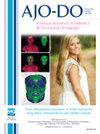柔性和刚性引导在骨锚定上颌磨牙远端:微型支撑摆与Beneslider。
IF 3
2区 医学
Q1 DENTISTRY, ORAL SURGERY & MEDICINE
American Journal of Orthodontics and Dentofacial Orthopedics
Pub Date : 2025-05-01
DOI:10.1016/j.ajodo.2024.11.015
引用次数: 0
摘要
简介:本研究旨在展示柔性和刚性矫治器设计对上颌磨牙远端的影响。方法:选取36例双侧II类磨牙关系,上颌第二磨牙完全萌出的患者作为研究对象。一半的患者使用微型支架支持的钟摆矫治器(组1;年龄16.5±2.1岁),另一半使用Beneslider矫治器(第二组;年龄(15.6±1.5岁)。使用侧位头颅x线片和数字牙科模型研究牙槽和骨骼的变化。结果:1组远端时间明显缩短(P = 0.006);然而,该组第一磨牙的远端倾斜程度明显较高(P = 0.030),远端倾斜程度较低(P = 0.022),在冠(P = 0.248),三分(P = 0.410)和根尖水平(P = 0.048)测量的比率较低。只有Beneslider组的根冠远端率为33.5%。1组SNB角降低(P = 0.010), ANB角(P = 0.010)和SN-GoGn角(P = 0.010)显著升高,2组均可忽略不计。组1第一磨牙的分布侧旋转明显高于对照组(P = 0.004)。上颌第二磨牙远端拔除量、远端拔除量和矫治成功率在两组间具有可比性。结论:Beneslider矫治器可以提供更快的上颌磨牙远端,大大减少远端倾斜和旋转。相比之下,微型支架支撑的钟摆矫治器导致下颌骨的后旋,恶化了矢状面和垂直面参数,并且不能在顶端提供远端。综上所述,我们的研究结果表明,刚性设计的上颌磨牙远端产生更有利的结果。本文章由计算机程序翻译,如有差异,请以英文原文为准。
Flexible and rigid guidance in skeletally-anchored maxillary molar distalization: The miniscrew-supported pendulum vs the Beneslider
Introduction
This study aimed to demonstrate the effects of flexible and rigid appliance designs on maxillary molar distalization.
Methods
Thirty-six patients with bilateral Class II molar relationships and fully erupted maxillary second molars were included in this study. Half of the patients were treated with the miniscrew-supported pendulum appliance (group 1; aged 16.5 ± 2.1 years) and the other half with the Beneslider appliance (group 2; aged 15.6 ± 1.5 years). Lateral cephalometric radiographs and digital dental models were used to study the dentoalveolar and skeletal changes.
Results
Distalization time was significantly shorter in group 1 (P = 0.006); however, the first molars in this group displayed considerably more distal tipping (P = 0.030), with lower distalization values (P = 0.022) and rates measured at the crown (P = 0.248), trifurcation (P = 0.410), and root apex levels (P = 0.048). Distalization at the apex level occured only in the Beneslider group, with a root-to-crown distalization ratio of 33.5%. SNB angle decreased (P = 0.010), and ANB (P = 0.010) and SN-GoGn angles (P = 0.010) increased significantly in group 1, all of which were negligible in group 2. Distobuccal rotation of the first molars was significantly higher in group 1 (P = 0.004). The amount of distalization, distal tipping of the maxillary second molars, and appliance success rates were comparable between the groups.
Conclusions
The Beneslider appliance provided faster maxillary molar distalization with substantially less distal tipping and distobuccal rotation. In contrast, the miniscrew-supported pendulum appliance led to the posterior rotation of the mandible, worsened the sagittal and vertical parameters, and failed to provide distalization at the apex. In summary, our findings indicated that a rigid design for maxillary molar distalization yields more favorable outcomes.
求助全文
通过发布文献求助,成功后即可免费获取论文全文。
去求助
来源期刊
CiteScore
4.80
自引率
13.30%
发文量
432
审稿时长
66 days
期刊介绍:
Published for more than 100 years, the American Journal of Orthodontics and Dentofacial Orthopedics remains the leading orthodontic resource. It is the official publication of the American Association of Orthodontists, its constituent societies, the American Board of Orthodontics, and the College of Diplomates of the American Board of Orthodontics. Each month its readers have access to original peer-reviewed articles that examine all phases of orthodontic treatment. Illustrated throughout, the publication includes tables, color photographs, and statistical data. Coverage includes successful diagnostic procedures, imaging techniques, bracket and archwire materials, extraction and impaction concerns, orthognathic surgery, TMJ disorders, removable appliances, and adult therapy.

 求助内容:
求助内容: 应助结果提醒方式:
应助结果提醒方式:


